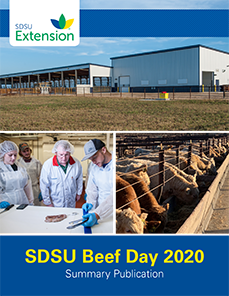
SDSU Beef Day 2020 Summary Publication
Document Type
Other
Publication Date
6-2020
Keywords
beef, carcass merit, ultrasound, imaging laboratory
Abstract
National cattle genetic evaluations assume technician and imaging lab do not contribute to phenotypic variation when measuring carcass traits by ultrasound. The objective of this study was to estimate variance components of ultrasound carcass measurements, specifically variance contributed by ultrasound technician and imaging laboratory. Accounting for technician and imaging lab variation may increase accuracy of genetic predictions for carcass traits. Ultrasound carcass predictions for ribeye area (REA), percent intramuscular fat (IMF), and backfat (BF) were provided by the American Angus Association (AAA; n=281,982 animals), American Hereford Association (AHA; n=49,602), and American Simmental Association (ASA; n=59,576) for a total of 391,160 animals. Data provided by each association included ultrasound carcass measurements, contemporary group, technician ID, imaging lab, and a three-generation pedigree for each animal with ultrasound measurements. Variance contributed by additive genetics, technician, and contemporary group on ultrasound carcass measurements were estimated for each breed separately. Because technician and lab were confounded, the contribution of lab to ultrasound carcass variation could not be separated from technician. Therefore, we assessed whether lab contributed to ultrasound carcass variation by estimating genetic correlations between laboratories for ribeye area, percent intramuscular fat, and backfat. This analysis separated carcass traits by laboratory and treated measurements interpreted by each lab as a separate trait. Technician explained 12-27%, 4-23%, and 4-27% of variance for IMF, BF, and REA respectively across all three breeds. On average, the variance contributed by technician was greater than the variance contributed by additive genetics but less than that explained by contemporary group. Genetic correlations between labs across breeds ranged from 0.79 to 0.95 for IMF, 0.64 to 0.94 for BF and 0.78 to 0.98 for REA. Technician contributed to variance in ultrasound measurements, but high genetic correlations between labs suggest lab plays a lesser role in contribution of variance to ultrasound measurements.
Publisher
South Dakota State University
Rights
Copyright © 2020 the Authors
Recommended Citation
Schmidt, B.; MacNeil, M.D.; and Gonda, M. G., "Evaluation of Variation Attributable to Lab and Technician for Measurements of Beef Carcass Traits Made Using Ultrasound" (2020). SDSU Beef Day 2020 Summary Publication. 22.
https://openprairie.sdstate.edu/sd_beefday_2020/22
